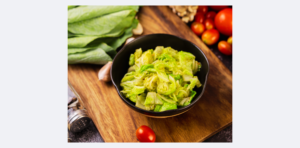
Benefits of Cabbage for Belly Fat and Cabbage Recipes for Humans and Pets and More Details.
Cabbage offers numerous health benefits, making it a valuable addition to a balanced diet. Here are some key advantages:
1. Nutrient-Rich
– Vitamins : High in vitamin C, vitamin K, and vitamin B6.
– Minerals : Contains potassium, calcium, and magnesium.
– Fiber : A good source of dietary fiber, aiding digestion.
2. Antioxidant Properties
– Rich in antioxidants like polyphenols and sulfur compounds, which help combat oxidative stress and reduce inflammation.
3. Supports Digestive Health
– The fiber content promotes healthy digestion and prevents constipation.
– Contains probiotics that support gut health when fermented (e.g., sauerkraut or kimchi).
4. Heart Health
– May help lower cholesterol levels due to its fiber and phytosterol content.
– Potassium in cabbage supports healthy blood pressure.
5. Cancer Prevention
– Contains glucosinolates, which are compounds that may help reduce the risk of certain cancers by supporting detoxification and reducing inflammation.
6. Weight Management
– Low in calories but high in nutrients, making it an excellent choice for weight loss or maintenance.
7. Immune Support
– High vitamin C content boosts the immune system and promotes skin health.
8. Bone Health
– Vitamin K in cabbage is essential for bone health and may reduce the risk of osteoporosis.
9. Versatile and Affordable
– Can be eaten raw, cooked, or fermented, making it a versatile ingredient in many dishes.
– Generally inexpensive and widely available.

Benefits of Cabbage for Belly Fat and Cabbage Recipes for Humans and Pets and More Details.
Incorporating cabbage into your diet can contribute to overall health and well-being.
While cabbage is highly nutritious and offers many health benefits, there are a few potential disadvantages or considerations to keep in mind:
1. Digestive Issues
– Bloating and Gas : Cabbage contains raffinose, a complex sugar that can be difficult to digest, leading to bloating and gas in some individuals.
– Fiber Overload : Excessive consumption of cabbage, especially raw, may cause digestive discomfort or diarrhea due to its high fiber content.
2. Thyroid Interference
– Goitrogens : Cabbage contains compounds called goitrogens, which can interfere with thyroid function, particularly in individuals with iodine deficiency or thyroid disorders. Cooking cabbage can reduce this effect.
3. Allergic Reactions
– Although rare, some people may have an allergic reaction to cabbage, leading to symptoms like itching, swelling, or difficulty breathing.
4. Vitamin K Interaction
– Cabbage is high in vitamin K, which plays a role in blood clotting. Individuals on blood-thinning medications (e.g., warfarin) should monitor their intake to avoid interference with their medication.
5. Pesticide Residue
– Conventionally grown cabbage may contain pesticide residues. Washing thoroughly or opting for organic cabbage can help reduce this risk.
6. Oxalate Content
– Cabbage contains oxalates, which can contribute to kidney stone formation in susceptible individuals if consumed in large amounts.
7. Flatulence
– The sulfur compounds in cabbage can cause unpleasant odors in flatulence for some people.
8. Overconsumption Risks
– Eating excessive amounts of cabbage may lead to nutrient imbalances or interfere with the absorption of certain minerals like iodine.
Tips to Minimize Disadvantages:
– Cook cabbage to reduce goitrogens and improve digestibility.
– Consume in moderation to avoid digestive discomfort.
– Pair with iodine-rich foods (e.g., seafood) to counteract goitrogenic effects.
– Wash thoroughly or choose organic to reduce pesticide exposure.
Benefits of Cabbage for Belly Fat and Cabbage Recipes for Humans and Pets and More Details.
Overall, cabbage is a healthy food for most people when consumed as part of a balanced diet. However, individuals with specific health conditions or sensitivities should be mindful of these potential drawbacks.
Cabbage can be a helpful addition to a diet aimed at reducing belly fat, but it’s important to understand that no single food can directly target fat loss in a specific area. Fat loss occurs through a combination of a calorie deficit, regular exercise, and a balanced diet. That said, cabbage can support weight loss and overall health in several ways:

*How Cabbage Helps with Belly Fat Reduction*
1. Low in Calories
– Cabbage is very low in calories (about 22 calories per cup), making it a great food for weight loss. It allows you to eat a large volume without consuming too many calories.
2. High in Fiber
– The fiber in cabbage promotes satiety, helping you feel full for longer and reducing overall calorie intake.
– Fiber also supports healthy digestion, which is important for maintaining a flat stomach.
3. Rich in Water Content – Cabbage has a high water content, which helps keep you hydrated and can contribute to a feeling of fullness.
4. Nutrient-Dense
– Packed with vitamins (like vitamin C and K) and minerals, cabbage supports overall health and metabolism, which are essential for effective weight management.
5. Supports Gut Health
– Fermented cabbage (e.g., sauerkraut or kimchi) contains probiotics that promote a healthy gut microbiome. A healthy gut is linked to better weight management and reduced bloating.
6. Anti-Inflammatory Properties
– Cabbage contains antioxidants and anti-inflammatory compounds that may help reduce inflammation, which is sometimes associated with stubborn belly fat.
Benefits of Cabbage for Belly Fat and Cabbage Recipes for Humans and Pets and More Details.
*How to Incorporate Cabbage for Weight Loss*
1. *Cabbage Soup*
– A popular option in many weight-loss diets, cabbage soup is low in calories and filling. However, it should be part of a balanced diet, not the sole focus.
2. *Raw in Salads*
– Add shredded cabbage to salads for a crunchy, low-calorie boost.
3. *Stir-Fried or Steamed*
– Lightly cook cabbage with other vegetables and lean protein for a nutritious, low-calorie meal.
4. *Fermented Cabbage*
– Include sauerkraut or kimchi in your diet for gut health benefits.
5. *Smoothies*
– Add a small amount of raw cabbage to green smoothies for extra nutrients and fiber.
*Important Considerations*
– Portion Control : While cabbage is healthy, eating excessive amounts can lead to bloating or digestive discomfort due to its high fiber content.
– Balanced Diet : Cabbage should be part of a balanced diet that includes lean proteins, healthy fats, and other vegetables.
– Exercise : Combine a healthy diet with regular physical activity, including cardio and strength training, to effectively reduce belly fat.
– Hydration : Drink plenty of water to support digestion and metabolism.
*Conclusion*
Cabbage can be a valuable tool in your weight-loss journey due to its low calorie count, high fiber content, and nutrient density. However, it’s not a magic solution for belly fat. Focus on a holistic approach that includes a calorie-controlled diet, regular exercise, and healthy lifestyle habits for sustainable results.
Here are a few simple and delicious cabbage recipes you can try:

Benefits of Cabbage for Belly Fat and Cabbage Recipes for Humans and Pets and More Details.
1. *Sautéed Cabbage*
Ingredients:
– 1 small head of cabbage, shredded
– 2 tablespoons olive oil or butter
– 1 small onion, thinly sliced (optional)
– 2 cloves garlic, minced (optional)
– Salt and pepper to taste
– 1 teaspoon apple cider vinegar or lemon juice (optional)
Instructions:
1. Heat olive oil or butter in a large skillet over medium heat.
2. Add onion (if using) and sauté until softened, about 3-4 minutes.
3. Add garlic (if using) and cook for 1 minute until fragrant.
4. Add shredded cabbage, salt, and pepper. Stir well.
5. Cook for 8-10 minutes, stirring occasionally, until the cabbage is tender but still slightly crisp.
6. Add apple cider vinegar or lemon juice (if using) and toss to combine. Serve warm.
2. *Coleslaw*
Ingredients:
– 4 cups shredded cabbage (green or purple)
– 1 large carrot, grated
– 1/2 cup mayonnaise
– 2 tablespoons apple cider vinegar
– 1 tablespoon sugar (optional)
– Salt and pepper to taste
Instructions:
1. In a large bowl, combine shredded cabbage and grated carrot.
2. In a small bowl, whisk together mayonnaise, apple cider vinegar, sugar (if using), salt, and pepper.
3. Pour the dressing over the cabbage mixture and toss until well coated.
4. Refrigerate for at least 30 minutes before serving to allow flavors to meld.
3. *Cabbage Soup*
Ingredients:
– 1 tablespoon olive oil
– 1 onion, chopped
– 2 carrots, sliced
– 2 celery stalks, sliced
– 4 cups shredded cabbage
– 4 cups vegetable or chicken broth
– 1 can diced tomatoes (14 oz)
– 1 teaspoon dried thyme
– Salt and pepper to taste
Instructions:
1. Heat olive oil in a large pot over medium heat.
2. Add onion, carrots, and celery. Cook for 5-7 minutes until softened.
3. Add shredded cabbage and cook for another 3-4 minutes.
4. Pour in broth and diced tomatoes. Add thyme, salt, and pepper.
5. Bring to a boil, then reduce heat and simmer for 20-25 minutes until vegetables are tender. Serve hot.
4. *Stuffed Cabbage Rolls*
Ingredients:
– 1 large head of cabbage
– 1 lb ground beef or turkey
– 1 cup cooked rice
– 1 small onion, finely chopped
– 1 clove garlic, minced
– 1 can tomato sauce (15 oz)
– 1 teaspoon paprika
– Salt and pepper to taste
Instructions:
1. Bring a large pot of water to a boil. Carefully remove the core from the cabbage and place the whole head in the boiling water. Cook for 5-7 minutes until leaves are soft and pliable. Remove and let cool.
2. In a bowl, mix ground beef, cooked rice, onion, garlic, paprika, salt, and pepper.
3. Carefully separate the cabbage leaves. Place a small amount of the meat mixture in the center of each leaf and roll tightly, tucking in the sides.
4. Place the rolls in a baking dish and pour tomato sauce over them.
5. Cover with foil and bake at 350°F (175°C) for 1 hour. Serve warm.
Benefits of Cabbage for Belly Fat and Cabbage Recipes for Humans and Pets and More Details.

Let me know if you’d like more recipes or variations! 😊
Cabbage can be a healthy treat for pets when prepared properly, but it should be given in moderation. Always consult your veterinarian before introducing new foods to your pet’s diet, as some animals may have specific dietary restrictions or sensitivities. Here are some pet-friendly cabbage recipes:
1. *Steamed Cabbage for Dogs*
Ingredients:
– 1 cup chopped cabbage (green or purple)
– Water for steaming
Instructions:
1. Chop the cabbage into small, bite-sized pieces.
2. Steam the cabbage in a steamer or boiling water until soft (about 5-7 minutes).
3. Let it cool completely before serving.
4. Serve as a small treat or mix it into your dog’s regular food.
Note: Avoid adding salt, butter, or seasonings, as these can be harmful to dogs.
2. *Cabbage and Carrot Mix for Dogs*
Ingredients:
– 1/2 cup chopped cabbage
– 1/2 cup grated carrots
– Water for steaming
Instructions:
1. Steam the chopped cabbage and grated carrots together until soft.
2. Let it cool completely.
3. Mix a small portion into your dog’s regular food as a healthy supplement.
3. *Cabbage and Chicken Treats for Dogs*
Ingredients:
– 1/2 cup cooked, unseasoned chicken (shredded)
– 1/4 cup steamed, chopped cabbage
– 1/4 cup cooked plain rice (optional)
Instructions:
1. Steam the cabbage until soft and let it cool.
2. Mix the shredded chicken, steamed cabbage, and rice (if using) in a bowl.
3. Serve a small portion as a special treat or mix it into your dog’s regular meal.
4. Cabbage and Pumpkin Puree for Cats
Ingredients:
– 1/4 cup steamed, chopped cabbage
– 1 tablespoon plain, unsweetened pumpkin puree (not pumpkin pie filling)
Instructions:
1. Steam the cabbage until soft and let it cool.
2. Blend the cabbage with pumpkin puree until smooth.
3. Offer a small amount (1-2 teaspoons) as an occasional treat. Cats may not eat much cabbage, so monitor their interest.
5. Cabbage and Turkey Bites for Dogs
Ingredients:
– 1/2 cup cooked, unseasoned ground turkey
– 1/4 cup steamed, chopped cabbage
– 1/4 cup cooked quinoa or oats (optional)
Instructions:
1. Steam the cabbage until soft and let it cool.
2. Mix the ground turkey, cabbage, and quinoa or oats (if using) in a bowl.
3. Form into small, bite-sized balls and serve as a treat. Store leftovers in the refrigerator for up to 2 days.
Important Tips:
– Moderation is key: Cabbage can cause gas in some pets, so introduce it slowly and in small amounts.
– Avoid seasonings: Do not add salt, garlic, onions, or spices, as these can be toxic to pets.
– Monitor your pet: Watch for any signs of digestive upset or allergies when introducing new foods.
Let me know if you’d like more pet-friendly recipes! 🐾